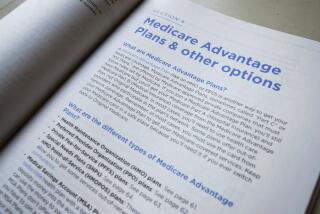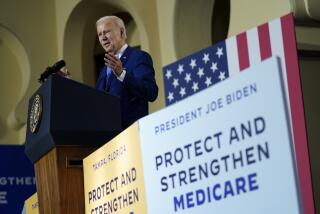Excess Choice Threatens Medicare’s Fiscal Prudence
- Share via
With Medicare costs growing at 7.2% a year, the 32-year-old federal health care plan for the elderly and the disabled is clearly in need of an overhaul. A shocking federal report last week that told of $23 billion being lost to possible fraud and abuse in 1996 has added fuel to the reform fire. A Senate and House conference committee, aware of these dismal numbers, is devising a final reform plan to present to President Clinton.
Media attention has focused on higher co-payments and a proposed higher eligibility age, but a lot more than that is tucked into the details. Some proposals are laudable, like “prudent purchasing” reforms to encourage competition between HMOs for Medicare dollars and new funding for preventive benefits like mammography and prostate exams. Others, however, work against what legislators say is their goal: giving consumers more choice and helping them spend their health care dollars more efficiently.
The biggest unheralded problems are two loosely regulated would-be alternatives to conventional Medicare: private fee-for-service insurance plans and medical savings accounts (MSAs).
In traditional Medicare, a patient’s bills are paid directly to doctors and hospitals, with rates capped by Medicare regulations. The patient pays only the usual deductibles and premiums . In the privatized versions being considered, doctor and hospital fees could vary widely. Proponents say the privatized plans would encourage competition among doctors and price shopping among beneficiaries. But when illness strikes, a plan may contain surprises. For instance, if the Medicare reimbursement cap for an operation is $4,000 but the doctor charges $10,000, then the patient could be liable for the additional $6,000.
Congress should ensure that Medicare’s approved rate limits also apply to the new privatized plans. Since their inception in 1990, the limits have been instrumental in controlling costs, helping reduce Medicare overbilling from 30% in 1986 to 4% in 1996. And the federal Medicare report found that only 8.5% of the $23 billion in possible fraud and abuse losses was due to overbilling. It would be simply bizarre to reduce the reach of Medicare’s rate limits in the name of economizing.
The MSA proposal now being debated would allow seniors to all but opt out of Medicare, accepting a huge $6,000 deductible and receiving their Medicare benefit as a tax-deferred savings account. The bottom line is that MSA clients would make money if they stayed healthy. But would this be fair? MSAs would disproportionately attract the affluent and healthy, leaving a sicker, poorer group to drain the traditional Medicare pool.
Congress must recognize that for many of the elderly and disabled recipients of Medicare, too much choice and too few protections can lead not to savings but to confusion.
More to Read
Get the L.A. Times Politics newsletter
Deeply reported insights into legislation, politics and policy from Sacramento, Washington and beyond. In your inbox twice per week.
You may occasionally receive promotional content from the Los Angeles Times.










